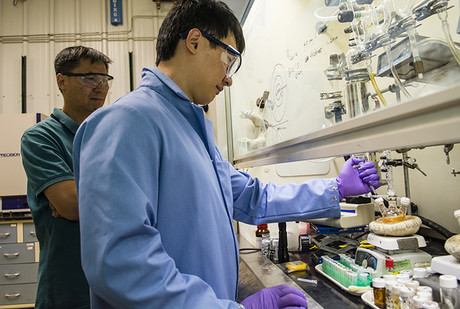Doctored quantum dots release laser light more efficiently

Researchers from the Los Alamos National Laboratory have created tiny semiconductor particles, called quantum dots, into which they can add extra electrons — a treatment that nudges the dots ever closer to producing the desired laser light with less stimulation and energy loss.
One of the secrets to making tiny laser devices such as ophthalmic surgery scalpels work even more efficiently is the use of quantum dots. But in order to force a material to emit laser light, one has to work towards a ‘population inversion’ — that is, making the number of electrons in a higher-energy electronic state exceed the number that are in a lower-energy state.
To achieve this condition normally, one applies an external stimulus (optical or electrical) of a certain power, which should exceed a critical value known as the ‘optical-gain threshold’. Now, researchers from Los Alamos’s Nanotech Team have demonstrated that by adding extra electrons into their specially designed quantum dots, they can reduce this threshold to virtually zero.
“When we properly tailor the compositional profile within the particles during their fabrication, and then inject two or more electrons in each dot, they become more able to emit laser light. Importantly, they require considerably less power to initiate the lasing action,” said Victor Klimov, leader of the Nanotech Team.
A standard lasing material, when stimulated by a pump, absorbs light for a time before it starts to lase. On the way to lasing, the material transitions through the state of ‘optical transparency’, where light is neither absorbed nor amplified. By adding extra charge carriers to their quantum dots, the Los Alamos researchers were able to block absorption and create the state of transparency without external stimulation — implying that even extremely weak pumping can now initiate lasing emission.
Another important ingredient of this research is the development of the new quantum dots, whose interiors are designed to maintain the lasing-active state for much longer than standard particles do. Normally, the presence of extra electrons would suppress lasing because quantum dot energy is quickly released not as a photon stream but as wasteful heat. The Los Alamos particle design eliminates these parasitic losses, redirecting the particle’s energy into the emission channel.
“These studies open exciting opportunities for realising new types of low-threshold lasing devices that can be fabricated from solution using a variety of substrates and optical cavity designs for applications ranging from fibre optics and large-scale lasing arrays to laser lighting and lab-on-a-chip sensing technologies,” Klimov said.
The research has been published in the journal Nature Nanotechnology.
3D semiconductor chip alignment boosts performance
Researchers have developed an ultra-precise method to align 3D semiconductor chips using lasers...
Researchers achieve 8 W output from optical parametric oscillator
Researchers have demonstrated a total output power of 8 W from a high-power mid-infrared cadmium...
"Dualtronic" chip for integrated electronics and photonics
Cornell researchers have developed a dual-sided chip known as a "dualtronic" chip that...






